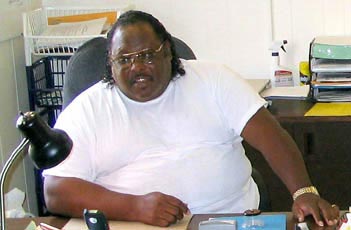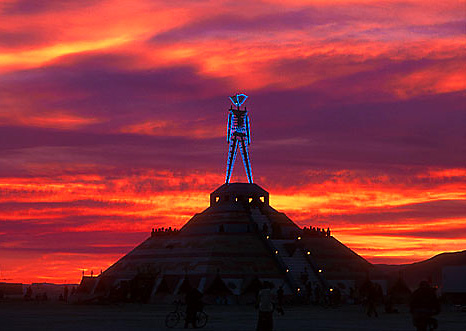
Chicken processing is a dirty business, but no job in a poultry plant is more dreaded than “live hang.” Here, workers known as “chicken hangers” grab birds by their feet and sling them onto fast-moving metal hooks. This is the first — and dirtiest — stage of poultry processing. The birds, weighing approximately five pounds each, fight back by pecking, biting, and scratching the hangers, who wear plastic cones around their forearms to shield off chicken attacks. Then, as workers finally hoist the birds onto the hooks, the chickens urinate and defecate out of desperation, often hitting the workers below.
The next stage — the “kill room” — may be bloodier, but most of the work there is done by laser-sharpened buzz-saws; only rarely does a chicken slip past the saw with its throat intact. Although no one has figured out how to sanitize the nasty job of hanging chickens, poultry managers pride themselves on the efficiency of their plants. One plant manager in Laurel, Mississippi, described his plant to me as “an automobile factory in reverse: They put cars together, we take chickens apart.”
Like many immigrant workers in the poultry industry, Esteban — a Veracruz, Mexico, native in his early twenties — agreed to work in “live hang” where he would colgar pollos only because it paid slightly better than other positions at the Peco Foods plant in Bay Springs, Mississippi. Nestled in the rolling hills of southern Mississippi’s “Pine Belt,” Bay Springs feels like a twenty-first century company town: Peco employs approximately 800 workers, while the total population of Bay Springs is around 2,000. At $8 an hour, chicken hangers at the Bay Springs plant make $1 to $1.50 more than other workers who debone, package, eviscerate, or kill chickens in other parts of the plant. In an industry with some of the highest turnover rates and lowest wages in the nation, chicken hanging has the highest turnover of any position. According to one manager I spoke to, workers in “live hang” rarely last a week before they ask to be transferred to another position. Others simply disappear, never to return to the chicken plant.
“You think you’d last a week here?” the manager asked me as he opened a door to the plant’s live hang room. For about five seconds, I watched men in a dark, sweltering room, (the darkness supposedly calms the chickens) struggle with a blur of feathers, dirt, and blood. A conveyor belt dumped chickens on the ground and about five men wrestled to get them on the hooks before the next load arrived.
“I probably wouldn’t last an hour,” I responded.
Despite the bleak conditions, Esteban flourished in his new job. With closely cropped hair, a slight build, and a collection of NBA T-shirts, Esteban had the air of a bright-eyed teenager. As an undocumented worker who spoke no English, he made the most of his limited opportunities in Mississippi; he got along well with his line supervisor and claims to have been able to hang over forty five-pound chickens per minute, an incredible feat considering the hazards of the job.
Then, after a year on the job, Julio Gordo, a manager at Peco Foods, called Esteban into his office. (To protect his identity, Julio Gordo is a pseudonym.) According to Esteban, Gordo told him that the Social Security Administration had notified Peco Foods that Esteban’s Social Security Number had repeated as a number for another worker.
At first, Esteban feared he would be fired by the plant and deported for document fraud — a fate not uncommon among undocumented workers. “Gordo told me he could have the cops here in five minutes if I didn’t cooperate with him,” Esteban confided to me later.

The no-match crisis: threats in the guise of favors
When I first met Esteban during the hottest days of last summer, he was reluctant to talk about hanging chickens, Peco Foods, Social Security Numbers, or anything else other than the new car he had bought with Peco wages. Like many immigrant workers in chicken plants, Esteban initially shrugged off my questions about hardships in the plant by saying, “I came here to work and I don’t want any problems.”
At the time, I was working as a translator for the local union, Laborer’s International Union of North America (LIUNA) Local 693, while gathering research for an academic paper focusing on the changing face of the South vis-à-vis the poultry industry. The management of Peco Foods decided to let me in the plant on one condition: that I work exclusively as a translator — and not as a recruiter — for the union.
I quickly learned that workers at Peco Foods had two mutually exclusive opinions about the plant: Inside the plant, they had no complaints about the work or their bosses; outside the plant, the workers despaired about what they saw as deplorable conditions and incessant harassment by managers. Many wondered why they had risked their lives to come to Mississippi only to slave away in a chicken plant. They longed for jobs picking fruit, cutting timber, or doing construction — anything besides hanging poultry.
Outside the plant, they accused managers of not paying overtime, charging workers money to keep their jobs, and denying workers bathroom breaks; inside the plant, however, they couldn’t be happier about Peco Foods. In the end, a job at the chicken plant represented a ticket to a new life for immigrant workers and few were willing to quit over perceived injustices. Esteban was no exception.
After Gordo allegedly threatened to deport Esteban, he reassured him that he could stay on at the plant if he could get a new ID and Social Security Number. Esteban knew this would be difficult; fake documents cost hundreds of dollars and were sold by only a handful of people in southern Mississippi on the black market. Furthermore, Esteban knew he would run the risk of being fired or deported if he bought a new Social Security Number, since he would be admitting his old one was false. Even with a new I.D., his seniority — including the two raises he had received for a year’s work — would be revoked. Esteban would be starting over from scratch.
Then, according to Esteban, Gordo told him he was willing to do him a “favor”: Esteban could buy a new Social Security Card from Gordo for $700. This was a favor Gordo had done for many other Mexicans in the same situation, he claimed. Still, the news came at a bad time: Esteban was trying to pay off traffic tickets and send money back to his family in Veracruz. He simply didn’t have the cash to pay off his supervisor. When Gordo also demanded that Esteban arrange a date for him with Esteban’s female cousin after work as a return “favor,” Esteban decided he had had enough. (In a conversation with a union representative, Gordo vehemently denied that he ever offered to “sell” documents to employees).
Esteban asked the plant’s union representative, Charles Carney, for advice. Although it was rare for an immigrant worker to talk to a union rep in the plant, Esteban felt he had no other choice than to turn to the union, since Gordo had threatened to terminate him if he didn’t accept the deal.
Carney listened in shock to Esteban’s story as I translated. “Tell him we need to talk to him at home,” Carney told me. “We can’t talk in here.”
Home, as we found out, was a run-down trailer park on the outskirts of Laurel, Mississippi, where many chicken workers lived. Tucked away behind the town’s Wal-Mart on an unpaved road, the unnamed trailer park looked more like a refugee camp than a subdivision; rotting garbage and abandoned pick-up trucks were the only landmarks. The day we visited, workers came out of their trailers to tell similar stories about Gordo first charging them to obtain jobs and then, after informing them of a Social Security “no-match” letter, demanding additional payment for providing new documents.
After a day of interviews, it became clear that the Social Security Administration (SSA) had sent a letter to Peco Foods with the names of workers whose Social Security Numbers did not match its records. Peco Foods then told these workers individually that they must “correct” the error or be fired within two weeks.
Although Peco officials are no longer officially commenting on the “no-match” situation, Steve Conley, the company’s human resources manager, told the Associated Press in August, “We didn’t realize there was a problem with these folks or we wouldn’t have hired them in the first place. At that point, we just told them, get it straight with Social Security or we’ll terminate you.” (Peco Foods did not respond to phone and email inquiries for this story.)
Carney, a former poultry plant worker himself, was incredulous when he heard that company officials claimed they were ignorant of the immigrants’ status. In fact, he was convinced that the company knew it stood to gain from employing workers who could be easily sacked because of questions about their papers and took advantage of their precarious legal status.
Carney’s union, LIUNA Local 693, had recently succeeded in ousting one manager accused of charging immigrants to obtain jobs, and his replacement — Gordo — was turning out to be even more problematic. Carney began to wonder if Gordo’s purported strategy of selling counterfeit documents to immigrants who had shown up as “no-matches” in the SSA’s database extended to higher-level managers in the company, and perhaps outside the plant.
After Esteban was fired weeks later, Carney called Peco Foods’ plant manager and threatened to file a grievance for a breach of the union contract unless the worker was reinstated and Gordo was fired. Carney claimed the worker was fired without just cause since, as far as he could tell, the “no-match” letter did not imply the worker was illegal, but rather that there had been some sort of error in his paperwork. The plant manager was surprised to hear a union representative — especially an African American — taking an interest in the plight of an immigrant worker.
“I thought you wanted [the immigrants] out of the plant, because they were stealing your jobs,” the manager said to Carney over the phone.
“If I’ve learned one thing over the past ten years,” Carney responded, “it’s, if you can’t beat ’em, join ’em.”
“He didn’t take that too well,” Carney told me later. “I think I heard him throwing a chair around his office.”

Learning to “speak Mexican” in the rural South
Carney, a stout Baptist deacon and veteran of the Vietnam War and many years in Mississippi chicken plants, is an unlikely convert to the immigrants’ cause. When he came back from the war, Carney found a job in the deep freeze section of a Sanderson Farms plant in Collins, Mississippi. He quickly gained a reputation as the only African American worker willing to stand up to a notoriously racist plant manager and helped to unionize three poultry plants in southern Mississippi. After nearly a decade of fighting to keep immigrants out of the local poultry plants, only to see their numbers increase steadily, Carney underwent a Pauline conversion in his attitude toward immigrant rights a few years ago.
Although he doesn’t “speak Mexican,” as he puts it, he believes immigrant workers and African Americans share many of the same problems in Mississippi poultry plants: Both are stuck in low-wage jobs with few chances to get ahead in a highly segregated society. They work in an industry that the Occupational Safety and Health Administration has designated as one of the most hazardous and that ranks near the bottom in Labor Department statistics for median wages. And as bad as conditions can be for African American workers on the processing line, Carney believes the immigrants’ situation is worse; in fact, he often compares it to slavery.
But while Carney equates “Big Poultry” with the plantation system, industry experts cite the huge economic impact of chicken on the state economy and its ever-expanding global market as Mississippi’s ticket out of its seemingly perpetual status as the nation’s poorest state. According to Mississippi State University poultry science reports, poultry contributes $2 billion to the state economy and nearly 70,000 jobs, making it the most important “agricultural” industry in the state. Since 1987, the number of Mississippi chickens sold has more than doubled to over 700 million per year, and poultry companies are increasingly looking abroad for new consumers. In 1990, the U.S. exported 500,000 metric tons of chicken overseas, while in the year 2000 that figure increased five-fold to 2,500,000, as China and Russia became the two largest consumers of U.S. chicken. Peco Food’s website proudly boasts company exports of “jumbo wings” and “jumbo legs” to Indonesia, China, Spain, and Romania, among other countries.
Like the plantation system, however, Big Poultry is largely a Southern phenomenon: The top six broiler-producing states are located in the South, with Georgia and Arkansas constantly battling for number one. And even though it is currently ranked as the fifth-largest broiler producer, Mississippi boasts the single largest processing plant in the U.S. — an ultra-modern Choctaw Maid plant built in 2000 in Carthage, capable of processing over 2 million chickens per week. It is this massive boom in poultry that is largely responsible for changing the rural South from a biracial, agricultural culture to a globalized entrepôt.
Despite the boom in poultry production, the industry has a notorious reputation with labor, environmental, and immigrants’ rights groups. Tyson, the world’s largest chicken processor, was labeled by Multinational Monitor magazine as one of the world’s “Ten Worst Corporations” in 1999 for its use of child labor. Then, Tyson became the subject of a thirty-six-count Justice Department indictment for human trafficking in 2001. Ever since three top-level Tyson managers were acquitted by a federal grand jury for smuggling immigrants to the South from Central America last year, the industry has faced increasing scrutiny on its recruiting and hiring tactics. The media spotlight on Tyson’s alleged trafficking in immigrant labor, combined with the economic downturn and security concerns in recent years, has made many locals — whites and African Americans alike — wary of embracing undocumented workers.
In another Peco Foods plant in Canton, Mississippi, a similar “no-match” crisis set off a crusade led by the town’s sheriff against Canton’s entire population of undocumented workers. After approximately 200 workers were fired by Peco because of the “no-match” letter, Sheriff Toby Trowbridge told the Clarion-Ledger — the daily paper in Jackson — that he would “round up” all “illegals” and “deport them.” Although many workers were finally reinstated after the plant’s union filed a grievance and national media started to take notice of the sheriff’s campaign to deport an entire trailer park populated by immigrants, the damage had already been done.
As Anita Grabowski of the Equal Justice Center, an Austin, Texas-based legal aid group that focuses on immigration, told me: “Most of the workers live paycheck to paycheck…. They had to find other work.” Grabowski worked on a campaign to get the workers reinstated and found the union in Canton — a local of the United Food and Commercial Workers — less enthusiastic than Carney’s local when it came to the plight of immigrant workers. Grabowski says that in the Canton case, union representatives were more interested in recruiting dues-paying members. At a July meeting for union members, Carney tried to convert other African American workers to his newfound cause. “They treat these Hispanics like they treated black folk back in slavery days,” he said. “Y’all got to stick together with the Latinos.”

The “Latinization” of the South
In a state still wrestling with ghosts of the Civil Rights struggle, Carney’s message gets a mixed reception in the black community. In towns throughout the South where poultry is king, working-class African Americans view the influx of Latino workers with suspicion. Although the South is famous for its insularity and chauvinism, the refrain “they’re stealing our jobs” is actually heard more in the black community than the white community, since few whites work processing-line jobs such as “live hang” and evisceration.
As Mike Cockrell, the chief financial officer of Mississippi’s largest poultry company, Sanderson Farms, told me during a tour of the company’s Laurel plant: “Jobs in chicken processing have been traditionally filled by black women. Many of these women are single mothers without much education. You can imagine it’s got to be a hard life trying to raise children and work fulltime at a chicken plant.”
Cockrell went on to argue that Hispanic immigrants — many of them indigenous people from southern Mexico and Central America — have a completely different conception of what constitutes a decent standard of living than Americans, but that Sanderson was committed to improving conditions in the plants. “Normal incentives to keep employees — health care, retirement, pensions — don’t work with immigrants,” he said. “They come here to work and send money back home.” Nevertheless, Cockrell maintained that Sanderson Farms was a “family-friendly” company; he cited Sanderson’s child-care facility in Collins, Mississippi, as an industry first. “We have people who work almost their whole lives here, and love it,” he said. “The guy in the kill room, he loves killing chickens. It’s hard to get him out of there.”
“He can say what he wants,” Carney later told me. “But the fact is, they care more about those chickens than they care about their people.” This is a truism repeated by processing-line workers everywhere. In an industry with annual turnover rates approaching 100 percent, the only constant in a chicken plant seems to be the endless line of upside-down birds whirling past the plant floor.
Because of increasing competition for these low-wage jobs, racial tension among Hispanic immigrants and African Americans runs high and occasionally boils over into a shouting match in the break room or parking lot. Carney fields calls daily from African American job seekers who claim to have been turned away from plants even as more immigrants are brought on. Poultry managers, for their part, maintain they simply can’t hire enough native workers to supply the booming demand for chicken, which Americans increasingly view as a healthier and safer alternative to red meat.
Even if immigrants are not, in fact, taking poultry jobs away from locals (Grabowski claims they are not), the negative reaction is as understandable as it is misconceived. Against the odds — Mississippi is notoriously anti-union — Carney helped organize three Mississippi poultry plants in the early 1990s: two Sanderson Farms plants and one run by Peco Foods in Bay Springs. About five years ago, after tough union certification drives and harassment by plant managers, things started to look up for the union and its members. The poultry industry was booming and the union had fought for and received wage hikes and other benefits.
Then, the immigrants began arriving. Native Mississippians working on the line were at first perplexed, then angry, as line-speeds increased and new jobs were filled by workers from parts of Mexico they had never heard of, like Oaxaca and Chiapas. The immigrants worked harder, faster, and never complained. Labor contractors brought in groups of immigrants and paid them separately from other workers, often deducting a cut for their “services.” Seemingly overnight, immigrants became the majority on the line at Peco Foods and a significant part of the Sanderson Farms plant.
Under the union contract, new workers aren’t allowed to join until after a ninety-day probationary period. When Carney tried to recruit immigrant workers for his union, he found that the labor contractor fired workers after exactly ninety days, only to rehire them the same day under a new name and Social Security number. He discovered that workers who complained about not receiving overtime were fired on the spot. Even after massive firings, the poultry plants were able to bring in new immigrant workers without missing production quotas.
The situation is not unique to southern Mississippi. Throughout the South, immigrants have started taking jobs in poultry and meatpacking plants in towns that, until recently, remained largely untouched by the great waves of immigration to the United States throughout the twentieth century. The impact of Latino immigration on the economy and culture of the South has been overwhelming, yet rarely examined. When the Census Bureau reported that the Latino population of the Southern states had tripled from 1990 to 2000, many people who follow immigration patterns thought that the Census had actually underreported the number of Latinos in the South. In Laurel, for example, the mayor and police officials consistently estimated the Hispanic population to be around 10 percent, while the census reported only 2 percent. Laurel residents say ten years ago, there was not one Mexican restaurant in town, whereas now there are at least four, plus three Mexican grocery stores.
This unprecedented immigration to the South represents a curious twist in the logic of global capitalism. “What’s unique about poultry,” Grabowski says, “is that unlike other sectors — like manufacturing — where companies have moved abroad in search of cheaper labor, poultry companies have, in effect, brought the cheap labor here. Poultry has combined the worst labor practices in agriculture with the worst practices in meatpacking.”
Immigrants to small Southern towns also struggle with life outside the plant. Although Mississippi has one of the lowest costs of living in the country, immigrants often pay over $1,000 a month for a rundown two-bedroom house or trailer. Rental markets in small towns in Mississippi are often controlled by a handful of landlords who gouge immigrants by charging rent per person, not per property. Under this scheme, half a dozen workers can be housed in small trailers, some without heat or running water. According to Laurel’s mayor, some poultry workers have even lived in tents by the town’s only shopping mall.
Responding to the “no-match” crisis
As Carney contemplated his options for responding to the situation at Peco Foods, he quickly learned more about the SSA’s “no-match letter”— the reason Peco had fired Esteban. Shortly after Esteban was fired, other workers started approaching Carney telling him that they, too, had been notified that they had shown up as a “no-match” in the SSA database and would be fired within two weeks if they did nothing to correct the problem.
Carney called other LIUNA locals and an immigrants’ rights group in Jackson. The “no-match” letter was not even on their radar; no one knew how to respond to the threat of mass firings other than to wish the immigrants luck in the next chicken plant. He arranged an ad hoc meeting at the Catholic church in Laurel with some bilingual immigrants’ rights advocates and asked workers to come. With less than twenty-four hours advance notice, approximately eighty workers showed up for the meeting.
After consulting with a team of lawyers and researchers from the Equal Justice Center and the National Immigration Law Center (NILC), Carney and his colleagues were finally able to get some background on the “no-match” letter. Both organizations are legal aid nonprofits that represent immigrant workers with immigration and labor issues. After every tax season, Carney learned, the SSA sends letters to employees whose Social Security Numbers do not match the name reported to the SSA through the Internal Revenue Service.
According to the SSA, the original purpose of these letters was to reduce the astounding $374 billion in the SSA’s “Earnings Suspense File” (ESF), an account that holds money paid into Social Security that cannot be linked to individual workers. However benevolent SSA’s intentions, the result of the government’s “no-match” campaign has been a disaster for immigrant workers, a group disproportionately affected by these letters. The National Immigration Law Center (NILC) estimates that tens of thousands of workers have been fired solely on the basis of the “no-match” letter.
What makes these mass firings particularly troublesome, according to Bill Beardall, director of the Equal Justice Center, is that the SSA has no law enforcement powers and does not “share” information with government agencies like Immigration and Customs Enforcement (the agency formerly known as the Immigration and Naturalization Service).
Although employers are supposed to submit a copy of the letter to the employee and allow him or her to handle the issue without interference by the company, the company often fires the employee on the basis of the letter alone. In the Peco Foods case, for example, the company created its own letter, which it required employees to submit and sign, in effect forcing them to admit that they are working illegally. Once they admit to having submitted counterfeit documents to the company, they must be fired under the terms of the 1986 Immigration Reform and Control Act, which prohibits employers from “knowingly” hiring undocumented workers.
None of this, of course, is explained to the immigrant, and companies such as Peco appear determined to keep immigrant workers in the dark about the “no-match” process; Peco sent out approximately sixty no-match letters last summer to immigrant workers and did not provide a Spanish translation until workers began to demand one. None of the workers were allowed to see the SSA’s original letter, which clearly states in boldface type (in English and Spanish) that the letter does not constitute grounds for any adverse action against the employee.
Furthermore, the letter states that if the employer does, in fact, take action against the employee, the company “may” (a key word whose ambivalence remains unresolved even by legal experts at NILC and the Equal Justice Center) be violating the employee’s rights under the 1964 Civil Rights Act. The workers were simply told — and sometimes urged on the spot — to sign the company’s letter and return it to Gordo as soon as possible.
The workers at the meeting in Laurel, however, appeared determined to fight for their jobs. With some emergency training and support from Beardall, the group of immigrants’ rights advocates gathered at Laurel’s Catholic church — including a freelance English teacher/translator and a Catholic seminarian — were able to explain to the workers that it would be illegal for the company to fire them without a just cause and that the “no-match letter” did not, in itself, constitute a just cause for termination.
Nevertheless, many of the immigrant workers doubted that the company would respect their legal rights as workers. After hours of discussion in Spanish and English, it became clear that the workers held a fundamental mistrust not only of their employer — Peco Foods — but also of the governmental institutions that regulate companies’ labor and safety practices. The immigrants simply could not believe that their rights would be respected by either the company or the government.
Foul-smelling victories
In a sense, immigrants are rightly skeptical of such institutions: Undocumented workers are often arrested for minor crimes such as public intoxication or excessive traffic tickets and then deported. If an undocumented immigrant chooses to testify in court against an abusive employer, he or she will almost certainly be asked about his or her employment eligibility and the source of his or her documents, which are often counterfeit. This means potentially exposing the coyote who brought him or her into the country, as well as family and friends. Also, a recent decision by the Supreme Court in Hoffman Plastic v. NLRB makes it even harder for undocumented workers to win remuneration after being fired. Even when undocumented immigrants are “unjustly terminated,” the court ruled, they do not have a right to sue their employer for back pay. Grabowski cites the Hoffman decision as a major factor in the Canton workers’ inability to win back pay after being unjustly fired. In sum, the cards are stacked against the worker and only those with nothing to lose — such as Esteban — are willing to come forward and tell their stories.
Ultimately, the group of workers assembled at the church in Laurel decided to hand in letters to the company stating that they were aware of the no-match problem and would look into it on their own; they would not admit to having submitted a false Social Security Number, as the company had asked them to. Workers reported that when Gordo learned of the meeting, he became furious and told them they “would pay a price” and that “the union couldn’t help them.”
Many of the workers — and Carney — feared that Peco Foods would fire them, regardless. Surprisingly, days, then weeks went by, and Gordo took no action. The chicken hangers kept hanging chickens and the debone line kept removing bones from meat. For the immigrants and their unlikely advocate, it was a small, quiet victory over a powerful industry, an industry whose influence has done more to change the face of Mississippi than anything since the civil rights struggle.
Weeks after the “no-match” crisis had passed, I found myself back in the Peco Foods break room gazing through a window onto the plant floor. A conveyor belt with metal hooks wound around an immense room from “live hang” to “cut up,” where a group of mostly Latina workers furiously separated chicken breasts from bones. The floor was like an ice-rink of chicken slime and water. The air was putrid as the smell from “further processing” — where the birds’ bones, guts, and waste are boiled into animal feed — hung in the humid Mississippi air.
A group of chicken hangers came through the door for a fifteen-minute rest. Most of their break is spent doffing and donning their uniforms, which are caked in chicken excrement and chicken guts, and the time left is usually spent smoking cigarettes and eating snacks from the vending machines. Two weeks after receiving their “no-match” letter, they weren’t basking in their victory over Peco Foods, but contemplating other jobs in Mississippi, anywhere but in a chicken plant.
“So you don’t want to stay here in Bay Springs now that you can keep your job?”
“I hear the timber industry is hiring,” one said. “Mejor que colgar pollos.”
STORY INDEX
MARKETPLACE >
(order from Powells.com and a portion of each sale goes to InTheFray)
Any Way You Cut It: Meat Processing and Small-Town America
Edited by Donald D. Stull, Michael J. Broadway, and David Griffith. University Press of Kansas. 1995.
An anthology of articles by anthropologists and sociologists tracing the transformation of small-town America through low-wage meatpacking jobs.
Purchase this book from Amazon or Powells
The Jungle
By Upton Sinclair. 1906.
The classic Upton Sinclair novel that forced the government to drastically reform working conditions in meatpacking plants in the early twentieth century.
Purchase this book from Amazon or Powells
ORGANIZATIONS >
Equal Justice Center
An Austin, Texas-based legal aid nonprofit that has been monitoring abuses in the poultry industry throughout the South.
URL: http://www.equaljusticecenter.org/PoultryWorker.htm
Occupational Health and Safety Administration (OSHA)
The governmental agency charged with maintaining safe working conditions in U.S. workplaces.
URL: http://www.osha.gov
National Immigration Law Center
A "national support center whose mission is to protect and promote the rights and opportunities of low-income immigrants and their family members."
URL: http://www.nilc.org
Laborers International Union of North America
One of the unions — along with the United Food and Commercial Workers — attempting to organize undocumented workers in poultry plants.
URL: http://www.liuna.org
TOPICS >
President Bush’s proposed immigration reforms
URL: http://www.whitehouse.gov/news/releases/2004/01/20040107-1.html
Russell Cobb
Dear Reader,
In The Fray is a nonprofit staffed by volunteers. If you liked this piece, could you
please donate $10? If you want to help, you can also:



















